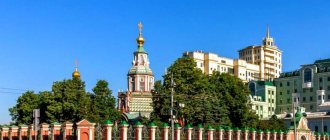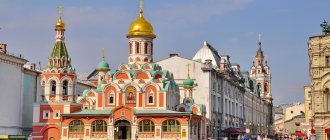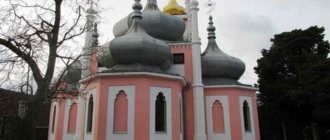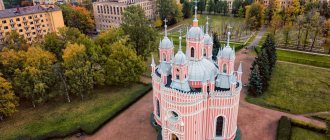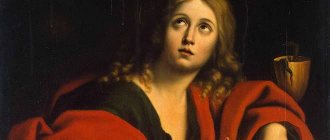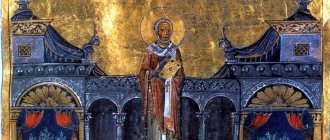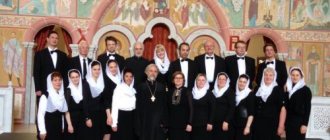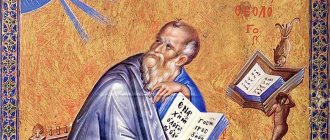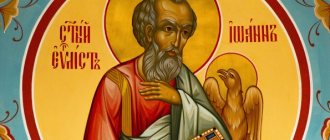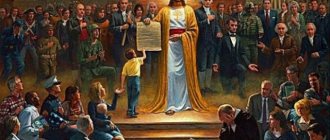Church of St. John the Evangelist
in the village of Krasnoye, Moscow.
The church in the name of the holy apostle and evangelist John the Theologian with the chapels of the holy chief apostles Peter and Paul (right chapel) and the holy noble prince Alexander Nevsky (left chapel) is located in Krasnoye Selo on the high bank of the Stradanka River near its confluence with Pakhra, about five kilometers away from the city of Troitsk. The church was built in 1703 by the Imeretian Tsar Archil Vakhtangovich Bagrationi on the promise of his son Tsarevich Alexander and consecrated in 1710. The right aisle was built and consecrated in 1786, and the left one was built in 1795; both of these chapels were built by Prince Alexander Petrovich Dadiani.
It is known about Tsarevich Alexander that he, an artillery general, was appointed by Peter 1 as head of the Pushkarsky order. In 1700 he was captured by the Swedes near Narva. Only after 10 years of captivity, after Poltava, having waited for the exchange of captured Swedish generals, Tsarevich Alexander never returned to his homeland. Sick, exhausted by long imprisonment, he died on the island of Pitea (in one of the bays of the Gulf of Bothnia) on February 20, 1711. He was buried together with Archil in the Sretenskaya Church of the Donskoy Monastery in Moscow. This church, located under the large cathedral, was also founded by King Archil. His story is described in more detail here: 03-Book_Artur Burmistrov selo Krasnoe….
The first mention of the Church of St. John the Evangelist in the village of Krasnoe dates back to January 1702, when “the armory goldsmiths Isai Vasiliev and Ivan Mikhailov contracted at the armory of the icon painter Kuzma Grigoriev and Miritinsky Tsarevich Alexander Archilovich, from his icon painter Nefed Gavrilov to gild 4 apostolic belts, prophetic and the mark of crucifixion.” The main construction, apparently, was completed in 1703, but then for several more years the deficiencies were eliminated. In 1706, King Archil writes:
Most powerful Tsar, Most Gracious Sovereign.
In the past Sovereign, in 1703, on the promise of his son Tsarevich Alexander in the Moscow district, in my estate near Moscow in the village of Krasnoe Pakhovo, I also built a stone church in the name of the holy Apostle and Evangelist John the Theologian, but that church has not yet been consecrated.
Most Gracious Sovereign, I ask Your Majesty to give a consecrated charter about that newly built church from the Patriarchal Treasury order.
Your Majesty's subject, Tsar Archil of Imereti. » « December 1706.
But “that year that church was not illuminated because it was not fully decorated due to peasant poverty,” but it was consecrated only in 1710 on September 25 by Archimandrite of the Donskoy Monastery Lavrenty.
In 1706, Daria Archilovna refused the village to Sofya Alexandrovna, who was married to Prince Yegor Leontyevich Dadiani, so the estate came into the possession of the Dadiani family. At the end of the 18th - beginning of the 19th century, the estate was owned by Alexander Petrovich Dadiani; apparently distinguished by his love for the church, he started a major reconstruction of the temple. He got the temple in the usual form for that time: the church itself was an octagon on a quadrangle, an altar apse was adjacent to it from the east, a refectory from the west, a bell tower was attached to the western side of the refectory, and a small extension to the north of the bell tower. The temple had platbands on the windows and octagonal flaps made of hewn brick; the brick walls were plastered with mortar and whitewashed, as can be seen from the surviving fragments.
The parish of the church was apparently large, since in 1774 a deacon was added to the clergy of the church, which was rare for the surrounding churches, and Prince Alexander decided to expand the church. In June 1784, he submitted a petition in which he writes: “... in my patrimony... there is a church... of a stone building in every condition, although to correct the service in the winter there is not a single chapel, for which purpose I wish to arrange a meal for this theological church the chapel in the name of the holy supreme apostles Peter and Paul again, and, moreover, on the real church, the octagon should be blocked again.”
This was followed by a resolution: “to allow the blocking, and to present a plan for the chapel to the entire church, with the meaning of where the chapel should be.” This is how the plan of the church of 1784 with the proposed extensions has reached us: on the right is the chapel, and on the left is “the meal, which will again be carried out by the building in the chapel of the chapel.”
But during construction there were large deviations from the planned plan: an altar apse was added to the aisle, the aisle and the extension to the refectory were extended to the west (this can be seen from the western windows of the right aisle that were changed or newly made during the construction of the bell tower and from the blocked window near the south-eastern pillar the same bell tower), the location of the windows was changed and the pillar between the windows of the refectory was not removed to widen the passage to the annex. Two years later, in August 1786, the work was completed and Prince Alexander submitted a “most humble request” to bless and consecrate the chapel. The dean of the village of Varvarin, priest Peter Ilyin, submitted a “most humble report” that the chapel was “built and in good order with all church splendor” and attached an inventory of the property of the chapel. It says that in the silver-plated and “in decent places” gilded iconostasis in three tiers there were “images of picturesque and skillful art”, above the royal doors “a circle was made in which the radiance was established.” The church was “from the inside podshchekoturin” (i.e. plastered) and “painted both the vault and the walls in the altar and in the church with paintings.” As usual, the “decree of Her Imperial Majesty the Autocrats of All Russia” followed - to consecrate the chapel, which was carried out on September 19, 1786 by Archimandrite Theophylact of the Savvino-Storozhevsky Monastery.
Seven years passed, and Prince Alexander submitted a new petition - to allow a chapel to be built in the northern refectory in the name of the Monk Alexander Svirsky (probably his saint; the five-altar church with the chapel of Alexander Svirsky in the village of Bogorodskoye, Vatutinki, was also already dismantled by that time), except of this, above the chapels, “over one chapel, build a bell tower, and above the other chapel, a tower similar to that bell tower, on which a clock will be placed; and between them, to decorate the temple, a porch with columns and a pediment, and all of it, as well as the old table, should be covered with iron.” Two years later, in August 1795, everything was already built and the chapel was ready for consecration, which was the report of the dean of the village of Voronov, priest Alexei Vasiliev. On August 9, the Moscow Ecclesiastical Consistory decided to send a decree to illuminate the chapel of Sretensky Archpriest John and to issue the Antimins to the Chudov sacristan, which was carried out (the antimins were issued from the Chudov Monastery).
Five years later, like no one else after Tsar Archil, Prince Alexander, who was jealous of the decoration of the temple, submitted a new petition:
of the Most Holy Governing Synod office to the member of the Most Reverend Seraphim, Bishop of Dmitrov, Vicar of Moscow May 22 days 1800. From the artillery, retired captain of the rank of major, Prince Alexander Petrov, son of Dadian
Most humble request!
In the patrimony of my Zvenigorod district, Khatunsky Tithe, in the village of Krasnoe Pakhovo, there is also a stone church in the name of the Holy Apostle and Evangelist John the Theologian with two chapels of the supreme apostles Peter and Paul; and Reverend Alexander Svirsky. In which the real church was plucked and the walls were painted; Some of the tweezers and paintings were damaged in some places at the bottom of the floor. That’s why I have a desire to correct all the damage; and pluck everything from the outside.
For this reason: Your Eminence, I most humbly ask for this my request to make your archpastoral resolution, and deign to correct the above-mentioned damage, and the plucking.
May ““ day, 1800 - Captain of the Major rank, Prince Alexander, Prince Petrov, son Dadian, put his hand to the request of the Artilerin.
When plastering the outside of the temple, old wall decorations and window frames were knocked off. From the point of view of a modern person, the temple has lost a very beautiful detail of decoration, but at that time the now boring plaster may not have seemed as ordinary as it does now.
Prince Alexander Petrovich Dadiani died on January 26, 1811 at the age of 58. His body rests in the Donskoy Monastery near the southeastern corner of the large cathedral.
Soon Russia was attacked by the French. Moving along the Great Kaluga Road, they destroyed many churches, including the church in Krasnoye Selo. The French were mainly interested in gold and silver - they tore the vestments from the icons, plundered all the church utensils, except for the preserved ones, the church lost the antimensions in the chapels, clothes from the thrones and altars, banners and several icons. Fortunately, the church was not set on fire.
Between 1813 and 1831, the chapel of Alexander Svirsky was re-consecrated in the name of the blessed Prince Alexander Nevsky. Perhaps it was consecrated this way after the French due to rising patriotic sentiments. After 1831, this chapel is already referred to everywhere as the chapel of Alexander Nevsky.
In 1829, there may have been a major renovation in the church, since on May 30 of this year a new antimension was issued to the church by priest Sergei Gruzinsky. Perhaps the iconostasis was made anew, since the metric for 1887 mentions the iconostasis “new, wooden, with gilded carvings, the carvings depict a vineyard,” the iconostasis was 4-tiered, the top of the royal doors was “semicircular with a bowl.”
In the same metric, priest Nikolai Pavlov Gromov describes other now lost details of the temple: the crosses on the church and side chapels were 8-pointed iron, with chains going down to the heads, there were crowns at the top of the crosses, a crescent at the foot, crosses on both bell towers there were iron 4-pointed ones. The domes and roof were covered with iron and painted green.
There were six bells:
in the first weight 103 pounds 29 pounds - 1661 kg,
in the second - 29 pounds 37 pounds - 481 kg,
in the third - 7 pounds 14 pounds - 118 kg,
on the rest the weight was not indicated.
The floor in the central aisle and the refectory was iron, and in the side aisles and the central altar it was stone. Among the ancient icons in the temple was the image of the apostle and evangelist John the Theologian, according to legend, brought from Greece by the temple builder, King Archil.
In 1908, several more alterations were made to the temple: a new entrance door was made, new window frames and “spirit heating” was installed - a basement was dug under the temple, a stove was installed there and heater ducts were laid under the floor. Drawings of the temple from the time when “spirit heating” was installed have also been preserved.
The stormy spirit of change of all the established good things brought into Russia through the “window cut into Western Europe” the seeds of the weed of paganism, which sprouted there during the era of the revival of ancient Greek values to replace Christian ones. These seeds sprouted, blossomed in the last century, and our people blossomed with them, and in this century we are reaping the fruits. The destruction of internal piety led to the death of external deanery, and the appearance of the temple after its closure at the end of the twenties began to reflect the state of people’s souls: the crosses were toppled, the bell towers, whose ringing excited them to church services and every good deed, were destroyed. Inside, the temple, like the soul, was filled with all sorts of vanity, so that prayer completely ceased to be offered in it: there was a club, a printing house, a weightlifting hall; The octagon, according to legend, was also used as a residential building. Finally, the temple began to be empty; treasure hunters occasionally wandered in there.
In the fall of 1990, bright days came again in the history of the temple: through the efforts of future parishioners, the temple began to be cleared of debris, Abbot Theodore (Volchkov), rector of the neighboring Bylovskaya Church in the name of the miracle of the Archangel Michael, held the first prayer services in the best preserved Peter and Paul chapel. The building was handed over to the parish community. On New Year's Eve 1991, the windows in the aisle were glazed, and soon heating appeared there - a potbelly stove. Prayer services became regular, and in the spring a temporary iconostasis was made.
Western façade. November 1998
In the summer of 1997, parishioners of the temple cleaned the Holy Theotokos spring located nearby near Stradan, which, according to legend, bears the name “Thunder”. This source is supposedly more than 250 years old, as evidenced by a 1748 coin minted by Empress Elizabeth found in it during clearing. In the deposited layers in the source, shards of ancient dishes and Dutch faience were also discovered, which obviously could not have gotten there during the years of Soviet power. The source owes its appearance to a thunderstorm, after which, under a tree on the bank of the river. Stradan, which flows into the river. Pakhru, a spring began to flow, and on the tree was an icon of the Mother of God. When cleaning the source, it was discovered that its walls were lined with white stone, which was used to decorate the church, and the depth was more than 2 meters. At the celebration of the Dormition of the Virgin Mary in 1997, the parishioners of the church, led by Fr. Michael, in a procession of the cross, went to the source, where its consecration took place.
Since then, processions of parishioners to the spring to pour holy water or bathe in it have become regular. Since 1998, parishioners have performed Epiphany bathing and dousing, led by a priest, in the Holy Mother of God spring on the river. Suffering, whose name is consonant with the Jordan and the suffering of Christ, who with his death atoned for our sins, from which we are annually cleansed in our “little Jordan.”
In the winter of 1997-1998, work continued on the restoration and installation of air heating from an autonomous coal-fired boiler house. Central water heating was removed because it had become prohibitively expensive. The floors in the church were opened and new air ducts were laid or old ones leading to the chapel were repaired. Peter and Paul. At the same time, preparatory work began in the chapel to build a baptismal sanctuary. The old floor covering was removed and consisted of three layers from different periods. The upper ceramic floor, laid in the 20th century, contained in the cracks the remains of melted lead, which got there during a fire in the printing house built in the chapel during the Soviet period. The two lower coverings were made of white limestone slabs - a characteristic material for the decoration of many churches near Moscow and Moscow.
Eastern facade of the temple. 2000
In the center of the chapel, a foundation was erected for the planned baptismal font. From the base of the font, a closed drain for “holy water” was built, leading outside the temple to the “Holy Well,” which was dug in the summer of 1998. The depth of the well is more than 5 meters, the inside is lined with red brick. The above-ground building of the “Holy Well” is also built of red brick and is more than 5 meters high. It is crowned with a brass dome with a cross. The project for the construction and decoration of the “Holy Well” was carried out by artist Anna Yaguzhinskaya.
In the summer of 1998, work began on reconstructing the roof over the refectory and the aisle of the ap. Peter and Paul and the construction of a new roof over the chapel of St. Blessed Prince Alexander Nevsky. Simultaneously with the opening of the roof, work also began on the construction of the second southern bell tower above the aisle of the ap. Peter and Paul, the height of the walls of which now reaches more than 3 meters. The height of the walls of the aisle ap. Peter and Paul was raised to a height of about 1.5 meters to the level of the walls of the refectory and the chapel of St. book Alexander Nevsky while maintaining the style of the temple. Along the perimeter of the entire temple, in addition to the portico, a white stone cornice was restored from self-made blocks, which saved significant money. They began to surround the temple with a new brick wall, built along the contour of the remaining foundation of the old wall. That same summer, with funds raised by parishioners and sponsors, a plot of land (~20 acres) was purchased next to the church along with a house - a former prosphora. Unfortunately, due to its disrepair, the house had to be dismantled, since it could no longer be repaired. With the onset of cold weather in 1998, restoration work continued inside the temple. During this period, a dry basement was built under the floor of the refectory for household needs. Following this, a single concrete floor was laid in the main aisle of the building. John the Theologian and the refectory, then in the chapel of St. Peter and Paul. The solea was also expanded and work began on finishing the walls with lime plaster in the chancel. Preparatory work has also begun to clear the premises of the chapel of St. book Alexander Nevsky for summer work.
With the onset of summer in 1999, the dilapidated iron roof over the refectory and the chapel of St. book Alexander Nevsky. The ceiling above the chapel, which had completely fallen into disrepair, collapsed. The walls of the chapel have been strengthened. Rails and channels are laid above the aisle for the construction of the roof and ceiling. All the old beams that held up the old roof were replaced with new ones. During the summer and autumn, a roof was built over both chapels, the refectory and the porch and covered with red-brown metal tiles. The constant leaks in the temple have stopped. In the summer, the foundation stone for a monument to Russian soldiers who died in wars was installed on the territory of the temple. In the autumn-winter period, finishing work was continued in the altar of the main chapel in the name of St. John the Theologian.
In the fall, eleven bells were brought to the church for the belfry, made with donations from sponsors at a military enterprise in the city of Sarov, the place of glorification of St. Seraphim of Sarov. The weights of the main bells are 1700 kg, 850 kg, 425 kg, 225 kg and 93 kg. Now there are only 15 bells in the temple. At the end of November, with the blessing of Metropolitan Juvenaly of Krutitsy and Kolomna, in the chapel of St. Peter and Paul, a stainless steel font was installed in the form of a cross with rounded ends measuring 2.5 x 2.5 m along the main axis of the cross and a depth of 1.5 m. The finishing work of the font is currently underway, but the first baptism has already taken place in it . Currently, an improved project for the reconstruction and restoration of the temple is being developed, taking into account the work done. The church community celebrated the 2000th anniversary of the Nativity of Christ with prayers of thanks for the restoration and strengthening of the church.
Throughout this time, the parishioners carried out restoration and repair work on the church community’s house, the condition of which at the time of the transfer was emergency and uninhabitable. The foundation and wooden walls were strengthened, which were later lined with clapboards on the outside and inside, two new stoves and a fireplace were laid out, a common refectory and kitchen were equipped, accommodation for workers and watchmen, water supply was installed, and an icon-painting and carpentry workshop was organized and equipped. There is a small garden and vegetable garden near the house. The church and community house has been transformed. Currently, it hosts Sunday parochial school classes and classes for teachers in a special program with seriously ill children with autistic syndrome, paid for by the community and sponsors. For children of parishioners at Christmas and Easter, children's parties and performances with prizes and treats are organized, in which the children themselves and their parents participate.
2001. Archival materials on the church were kindly provided by Vyacheslav Tyutin.
Last years
At the end of January 2000, Fr. Mikhail was relieved of his duties as rector of the temple at his own request due to his state of health. On January 18, 2000, with the blessing of Metropolitan Juvenaly, Fr. Igor (Igor Anatolyevich Nikandrov). Then the priest Fr. began to serve with him in the church. Sergiy (Sergey Vasilievich Denisov)
During their ministry, a lot of work was done to improve and beautify the temple. A marble floor was laid in the temple building, running water was installed and central heating was connected, and a beautiful large chandelier was hung under the dome. The inside of the temple was plastered and whitewashed; The area around the church was put in order: a permanent fence was built, paths were paved, along which flower beds were laid out. All this was done with the active participation of parishioners and their efforts.
A temporary bell tower is built in the open air under a canopy; the ringing of its five bells can be heard far in the area.
Special mention should be made of the iconostasis. It was erected through the efforts of the entire parish over several years. Now he appears in all his splendor. The carved wooden decor was made by a team of carvers under the guidance of the talented master Yu.V. Cousin. The icons were painted by hereditary icon painters from the city of Mstera, Vladimir region, under the leadership of V.A. Lebedeva. They are made in the tradition characteristic of Mstera, the highest flowering of which occurred at the beginning of the 20th century.
All work was carried out with donations from parishioners, ranging from the “widow’s mite” to large contributions. The iconostasis in the chapel of St. apostles Peter and Paul. However, there is still a lot of work to be done: it is necessary to make an iconostasis in the chapel of St. Prince Alexander Nevsky, to paint the internal walls and vaults of the temple. It takes a lot of effort to maintain the temple and grounds in decent condition.
We hope that God’s help will not stop the godly work
restoration of this and other churches for the salvation of human souls and in it a prayer will be offered “for the beautifiers, beautifiers, and sacrificers of this holy temple,” until God is pleased to put an end to this world in order to come in His glory and reward every person according to his affairs. The Krasnoye estate complex, which in addition to the temple includes the Saltykovs' estate house, an outbuilding and a park, is included in the state register as an architectural monument - an object of cultural heritage, its status is protected by the state.
Application.
HISTORICAL REFERENCE
CHURCH OF JOHN THE BOGOSLOV IN THE MANOR RED
(Pakhovo, Krasnaya Pakhra)
While the residential and economic estate complex in Krasnoye had a complex, multi-stage history of its development (details about it, as well as about all the famous owners of the village, which changed its name more than once over the centuries, are described in another special reference written by us ), the construction history of the local temple is much shorter and much simpler.
Apparently, the now existing stone Church of St. John the Evangelist was the very first church building in this populated area. This conclusion inevitably follows from the documentary evidence that we have. Until 1703, Krasnoe and Pakhovo were also referred to as a village, that is, they appeared as a settlement without a church. Pakhovo appears as such according to documents under all its owners throughout the 17th century: under the princes of Cherkasy (1627 - 1648) and Miloslavsky (1648 - 1699).
A similar situation (that is, the absence of a church) is established according to the acts of the 16th century, when the owners of the village were first small patrimonial landowners Pakhovs, who gave it a new name instead of the previous one - Zubtsovo (Zubtsovskaya), and then (from the late 1560s) - Moscow Simonov monastery. At the same time, the mentioned acts (1535 - 1536, 1553 - 1554 and 1568 - 1569) speak of Pakhov or Zubtsov as a village.
The idea of building a temple in his estate near Moscow - Krasnoye, Pakhovo, or Pakhovo - came to the Imeretian prince Aleksaidr Archilovich somewhere in the late 1690s. Having received the village into full ownership in 1699 after the death of his wife Fedosya Ivanovna (nee Miloslavskaya, whose dowry included this hereditary patrimony), Tsarevich Alexander did not have time to bring his plan to fruition, as he soon went to the theater of military operations - to command the Russian artillery in the campaign against the Swedes. Having participated in the unsuccessful siege of Narva for the Russians, on November 20, 1700, he was captured by the enemy, from which he was never able to return and died there at the beginning of 1711.
During the absence of the captive prince, his father, the former Imeretian and Kakheti king Archil Vakhtangovich, who finally settled in Russia in 1699, took care of his property and all economic affairs. It was he who submitted a petition on May 6, 1703 for permission to carry out “ the promise of my son Alexander to build in the Moscow district, in his estate near Moscow, in the village of Krasnoye, Pakhovo, also, a stone church in the name of John the Theologian...” On December 24 of that year, permission followed from the Patriarchal Treasury Order to approve the land allocated to it by the patrimonial owner for the future church. In December 1706, Tsar Archil submitted a new petition to the same Order, where he already reported: “I built a stone church in the name of the Apostle Evangelist John the Theologian, but that church has not yet been consecrated.” The “consecrated letter” requested for this occasion was issued, but the consecration of the temple was somewhat delayed. It is known that at least until 1709 it had not yet taken place (data from the census book). But in 1712 the church was undoubtedly already active, for then “church tribute” was paid. At the time of the opening of the Church of St. John the Theologian, it included a “court of priests,” “a court of sextons,” “a court of sextons,” and a “court of mallow farmers,” and its parish consisted of a “court of patrimonial estates” and 100 courtyards of “medium peasants.”
The stone temple, built through the efforts of Tsar Archil according to the vow of his son Tsarevich Alexander in the Krasnoe estate, is a typical example of Moscow Baroque architecture at the turn of the 17th - 18th centuries. The building was built of brick and its original decorative decoration featured numerous white stone details (basement, window casings, etc.). The architectural composition was built by an architect unknown to us, focusing on the then popular type of temples - “octagonal on quadrangular”. The church itself, which was a two-height cubic volume with paired window openings, was adjoined by a semicircular apse to the east and a small refectory to the west. There was a chapel attached to the refectory on each side.
All these elements were included as components in the planning structure of the current building of the Church of St. John the Evangelist, which was formed after its reconstruction and expansion somewhere in the middle of the 19th century, when the entire Krasnoe estate, including the main house, underwent reconstruction. Then a second aisle (almost symmetrical to the south) was added to the church on the north side. On the western (end) facades of both aisles, paired bell towers were erected, and between them there was a main entrance to the temple with a white stone staircase that leads to a four-column portico crowned with a powerful triangular pediment. At the same time, the original decor of the building was hidden under a layer of plaster. All facades received a new, uniform Empire design and a characteristic two-color (yellow-white) painting. Here and there (on the eastern edge of the octagon, in niches-cases on the northern aisle) picturesque “inserts” - images - appeared. The reconstructed temple took on the appearance of a completely ordinary, but quite good example of Russian architecture of late classicism in its provincial estate version.
Subsequently, the monument underwent some changes in its appearance. But they are already associated with the loss of its original function in the twentieth century and all the negative consequences ensuing from this.
The post-revolutionary closure of the church and the use of its building for economic and other inappropriate purposes led to the loss of individual elements or their distortion. Thus, after the collapse of the octagonal drum and dome that crowned the octagon in the 1960s, part of the temple’s completion, which played the most important role in the construction of the architectural composition, was lost. Around the same time or somewhat earlier, wooden extensions (now missing) were added to the northern façade. A plank extension with a staircase leading upstairs was placed on the northern edge of the quadrangle, and therefore the western window of the second light was turned into a door, cutting out the opening. After the aforementioned wooden vestibule and staircase were removed, traces of alterations to the window openings associated with their construction remained visible on the newly opened facades. The southern wing of the building (southern aisle) also underwent alterations (window openings were partially blocked, etc.). All of the listed changes are easy to read on the facades and the preparation of a restoration project for the monument for the mid-19th century. should not encounter much difficulty.
Candidate of Historical Sciences A.A. Molchanov, 1996
Current state and operating time of the Church of St. John the Evangelist on Ishna
The church is perfectly visible from the Yaroslavl highway and from the railway track. But it makes the most powerful impression at close range. The houses of the village of Bogoslovo are far enough away from the church, so nothing interferes with its view from all sides.
From the outside, the wooden church looks majestic, strict and laconic. The area around it is surrounded by a low openwork wooden fence attached to brick posts. On the territory of the Yaroslavl region, this is the only wooden religious building that has survived to this day from the 17th century.
Now the temple is inactive and is under the jurisdiction of the Rostov Kremlin Museum-Reserve. The church is protected as a monument of ancient Russian wooden architecture.
Smoking and lighting open fires is strictly prohibited near the building.
You can go inside the church from May to September, from 10.00 to 17.00, any day except Wednesday. Divine services are held here only twice a year.
Renaissance
The unfinished stone church was handed over to the local community of believers only in the spring of 1991 - dilapidated and ruined, and soon, on the day of its patronal feast, the first prayer service was held. The temple was missing domes and crosses, and there were holes in the walls. For many years, waste from surrounding construction sites was dumped here.
At the beginning of 1992, restoration work began. And so on October 17, 1999, the main altar of the temple was consecrated. Two years later, the city authorities decided to make October 9 - the day of celebration of the repose of the holy Apostle and Evangelist John the Theologian - a city day.
How to get to the Church of St. John the Evangelist on Ishna
The temple is located in the village of Ishna (Bogoslovo), 3 km southwest of Rostov the Great.
By car. The federal highway M8, connecting Moscow and Arkhangelsk, leads to Rostov the Great. From the capital to the city - 220 km, and from Yaroslavl - 55 km. Moving from Moscow along the Yaroslavskoye Highway, you need to take a right turn towards the Rostov Kremlin and turn left to Shurskol and Zhoglovo. Then, after the railway crossing, turn right towards Bogoslovo. The journey by car from Rostov to the temple takes 10-15 minutes.
On your own by train and bus. It is convenient to get from the capital to Rostov on Yaroslavl express trains. They depart twice a day - at 8.20 and at 16.20. The train takes about three hours to Rostov. You can take a taxi from the city center to the church.
Attraction rating
Rating 4.67 [3 vote(s)]
| ← Russia | Yaroslavl region | Europe → |
After the revolution
In 1923, the Dulevo residents made a timid attempt to complete the construction of the temple and turned to the authorities for permission. However, they encountered a sharp refusal. Soon the unfinished building was converted into a dormitory. After the war, starting in the mid-1950s, a warehouse was placed in the premises of the unfinished church, and in 1970 it was completely abandoned and fell into the arms of inexorable time.
Locals slowly took away the bricks for household needs, and the boys lit fires inside the crumbling church. In the end, the authorities decided to demolish it altogether. However, the demolition workers, having examined the “object,” announced that very expensive work was ahead, since the architect Scherer built the church soundly, to last. The explosion, fortunately, never occurred.
